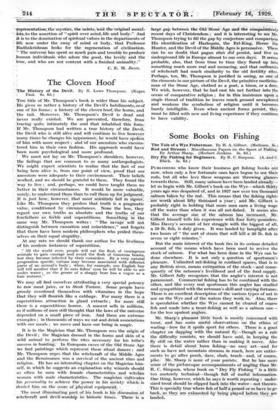The Cloven Hoof
4rHE title of Mr. Thompson's book is wider than his subject. He gives us rather a history of the Devil's habiliments, or of . one of his forms ; a history of the cloven hoof, the horns, and the tail. Moreover, Mr. Thompson's Devil is dead and never really existed; We are prevented, therefore, froni -tracing quite intimately the soul that inhabited - this form: If Mr. Thompson had written a true history of the Devil, the Devil who is still alive and will continue to live however Many times hi changes his appearance, be would haVe .sPoien =of him with more respect; and bf our ancestors 'who --noun= 'tered him in their own fashion. His approach would have been more psychological and more profound.
- We must not lay on -Mr: Thompson's shoulders, however, "the failings that are common to so many anthropologists. . We might expect scientists to realize that the fact of our being here alive is, from our point .of view, proof that our 'ancestors were adequate to their environment. Their beliefs 'worked, and we should be grateful to them. They found' the Tway to live ; and, perhaps, we could have taught them no ;better in their circumstances. It would be more- valuable; :surely; to understand. them than to call themup for judgment: It is just -fiere,:: hoWeVer, _that' most seientistS fait in Like Mr. Thompson they profess that truth is a pragthatic value, conditioned by circumstances. None the less, they regard our own truths as absolute • and the truths of our .. Something -forefathers feeble and superstitious. Something in the same way Mr. ThOmpson writes : " The Savage- will not distinguish between causation and coincidence," and forgets that there have been- modern philosophers who prided them- -selves on their equal stupidity.
At any • rate we should thank our author for the liveliness of his modern instances of superstition.
will eat " All the world over, people will eat the flesh of courageous animals to gain courage and avoid the flesh- of timorous beaStfi, lest they .become infected •by their cowardice. By .a -Very natural progression specific virtues may become . associated with different .parts of an animal's body ; when, for example, one English boy will tell another that if he eats fishes' eyes he will be able to see under water ; or the grease of a shaggy bear has a vogue as a
-hair restorer." •
We may all find Ourselves attributing a very special potency to raw meat juice, or to Steak Tartare. Some people have grossly overdosed themselves with vitamins in the hope -that-they will -flourish like a cabbage. For many there is a superstitious attraction in gland extracts ; for more still . there is a superstitious horror. A mascot sells in millions, as if millions of men still thought that the laws of the universe depended on a small piece- of iron. And these are extreme examples ; in thousands of ways we eat and drink associations with our Meals ; we move and haVe _our being in magic.
It is in the Magician that Mr. Thompson sees the origin of the Devil ; the Magician dressed in the horns and skin of a wild animal to perform the rites necessary for his tribe's success in hunting: In Eutopetin caves of the 'Old Stone Age we find paintings which represent these ritual dances ; and Mr. Thompson urges that the witchcraft of the Middle Ages and the Renaissance was a survival of the ancient rites and religion. He has an interesting chapter 'on the Magician him- self, in which he suggeits an explanation why wizards shoidd so often be men with • female characteristics :and witches women with male characteristics. The magician 7clidtivates his personality to achieve the power in his society .Which: is denied him on the seine, of phYsieal equipment.
The most illuminating part of his book is his discussion ,of witchcraft and devil-worship in historic times. There is a
ilaige gat, between the Old-Stone Age and-the companitiVely recent days of Christendom ; and it is interesting to see Mr. Thompson trying to fill the gap by conjecture and comparilsOn His identification of Harlequin, the Ert-King, Herne the Hunter, andthe Devil of the Middle Ages is persuasive. There can be. no doubt that pagan rite's did persist, and live an - Underground life in Europe almost to our own days: It seeins probable, also, that from time to time they flared up into something much more real and menacing, and that outbursts of witchcraft had much similarity to the old fertility rites. Perhaps, too, Mr. Thompson is justified in seeing, as one of the elements in our picture of the Devil, the primitive medicine. man of the Stone Age, clothed as a goat, a bison, or a deer. We wish, however, that he had cast his net further into the ocean of comparative religion ; for in this insistence upon a single thread of tradition he leaves much ground unexplored and weakens the symbolism of religion until it becomes barely intelligible. Even when ancient forms persist, they must be filled with new and living experience if they continue to have validity.










































 Previous page
Previous page